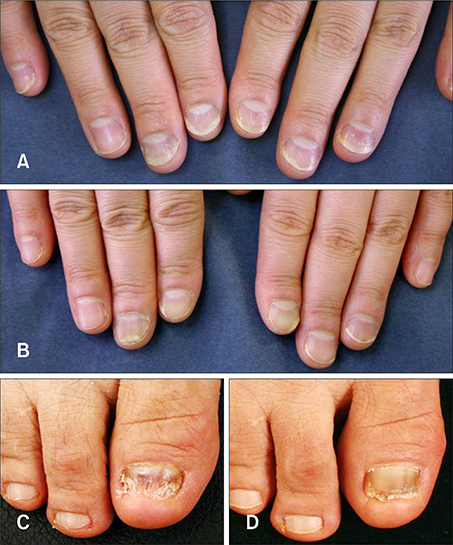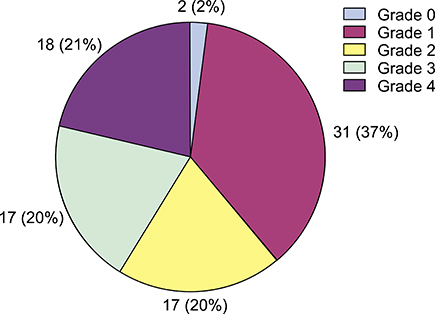Ann Dermatol.
2008 Mar;20(1):6-10. 10.5021/ad.2008.20.1.6.
Treatment of Chronic Idiopathic Onychodystrophy with Intake of Carotene-rich Food
- Affiliations
-
- 1Department of Dermatology and Cutaneous Biology Research Institute, Yonsei University College of Medicine, Seoul, Korea. kychung@yuhs.ac
- KMID: 2156351
- DOI: http://doi.org/10.5021/ad.2008.20.1.6
Abstract
-
BACKGROUND: Onychodystrophy refers to the various abnormalities in nail morphology due to changes in the attachment of the nail plate, changes in nail surface or color. The treatment principle of onychodystrophy largely relies on the discovery and verification of the cause. However, preventive treatment methods offer little help to the patient due to poor compliance, and the effect of corticosteroid is only temporary.
OBJECTIVE
To evaluate the clinical efficacy of carotene-rich food intake in chronic idiopathic onychodystrophy.
METHODS
Ten patients with chronic idiopathic onychodystrophy were recommended to drink one or two cups of carrot juice daily.
RESULTS
Patients showed improvement of onychodystrophy after drinking carrot juice twice a day for at least 4 weeks. No specific adverse effects were noted.
CONCLUSION
Since there are no reliable treatment methods for chronic idiopathic onychodystrophy, we suggest a simple and compliant treatment method consisting of taking carotene-rich food, such as carrot juice, for patients with chronic idiopathic onychodystrophy.
Figure
Reference
-
1. Daniel CR. Onycholysis: an overview. Semin Dermatol. 1991; 10:34–40.2. Hsu MM, Huang YR. Chronic onycholysis dramatically responds to enhanced intake of carotene-rich food. Br J Dermatol. 2002; 147:389–391.
Article3. Grover C, Bansal S, Nanda S, Reddy BS. Efficacy of triamcinolone acetonide in various acquired nail dystrophies. J Dermatol. 2005; 32:963–968.
Article4. Kechijian P. Onycholysis of the fingernails: evaluation and management. J Am Acad Dermatol. 1985; 12:552–560.
Article5. Paiva SA, Russell RM. β-carotene and other carotenoids as antioxidants. J Am Coll Nutr. 1999; 18:426–433.
Article6. Wang XD, Russell RM. Procarcinogenic and anticarcinogenic effects of β-carotene. Nutr Rev. 1999; 57:263–272.
Article7. Tavani A, La Vecchia C. β-carotene and risk of coronary heart disease. A review of observational and intervention studies. Biomed Pharmacother. 1999; 53:409–416.
Article8. Frieling UM, Schamberg DA, Kupper TS, Muntwyler J, Hennekens CH. A randomized, 12-year primary-prevention trial of beta-carotene supplementation for nonmelanoma skin cancer in the physician's health study. Arch Dermatol. 2000; 136:179–184.9. Bendich A. Biologic functions of dietary carotenoids. Ann N Y Acad Sci. 1993; 691:61–67.10. Marsden RA, Dawber RP. Erythropoietic protoporphyria with onycholysis. Proc R Soc Med. 1977; 70:572–574.11. Sayre RM, Black HS. Beta-carotene dose not act as an optical filter in skin. J Photochem Photobiol B. 1992; 12:83–90.
- Full Text Links
- Actions
-
Cited
- CITED
-
- Close
- Share
- Similar articles
-
- Therapeutic Effect of Intra-lesional Triamcinolone Injection on Idiopathic Onychodystrophy
- Factors Effecting the Bioavailability of Carotenoid in Elderly Korean Women
- Comparisons of food intake between breast cancer patients and controls in Korean women
- Dietary Carotene Intake and Suicidal Ideation in Korean Females: Analysis of Data From the Korea National Health and Nutrition Examination Survey (2012, 2013, and 2015)
- Food Behaviors, Nutrient Intake, Clinical Symptoms and Hematological Findings by Smoking Status among Male High School Students



